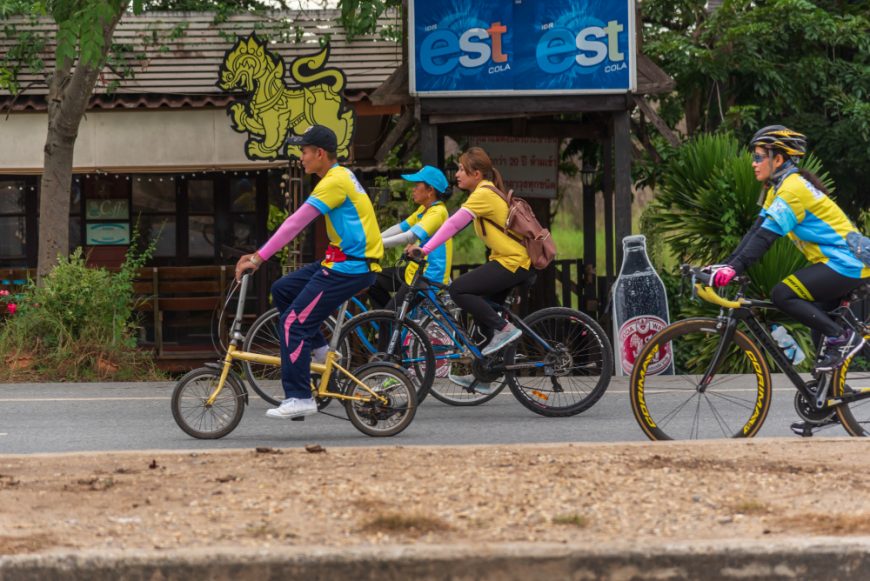Bicycles are no longer just a mode of transportation, instead, they are a symbol of freedom, style, and sustainability. They are nature-friendly because of their zero emissions. But the rise in bicycle popularity is nothing new.
Bicycles have been around since 1817. Were they always called bicycles? I am glad you asked. Well, in the start, they were known as the “swift walker”. With time, bicycles have led to the evolution of different traditions around the globe. Although these traditions are unique and vary from country to country, they all have the same purpose, to celebrate the art of cycling.
Let’s navigate through the dusty routes of the past to the colorful streets of today to explore the traditions that are famous worldwide.
Bicycle Traditions Around The World

Bicycles are now considered unofficial cultural ambassadors. They embody a fusion of the past and present as they wheel into the future. Here are some bicycle traditions around the world that surely caught my eye:
1. The Traditions Of San Francisco
In 1992, a very basic activity originated in San Francisco but soon it spread across cities worldwide like wildfire. In this activity, on the last Friday of each month, cyclists would gather in a specific spot. This spot was usually the central point in the city.
The participants rode in masses across the city to raise awareness about road safety and to advocate for better cycling infrastructure. Originally, they were putting forward the motion that cyclists have every right to use the roads just as the drivers of other motor vehicles.
This gathering eventually came to be known as the Critical Mass. These events are generally peaceful and their only aim is to promote a safer community.
Get a sneak peek into the latest trends and advanced technology that are shaping the future of cycling
2. The Tradition Of Tour De France
The Tour de France was first organized in 1903 as a men’s multiple-stage bicycle race. This event gathered so much attention that it was decided to conduct a Tour every year. Typically, this race stretches over three weeks in July.
As the name suggests, the race covers various areas in France and sometimes stretches over to neighboring countries too. Tour de France is the most prestigious race attracting professional racers and teams from all over the world. Initially, the races were only organized for men. But today, there is also a separate event for women known as Tour de France Women.
3. The Flying Lanterns Of Taiwan
In Taiwan, an annual Lantern Festival takes place in February every year. These Lanterns are made of oiled rice paper held firm using bamboo sticks. People let go of these lanterns in the sky as a gesture of goodwill for their futures. It is believed that letting go of a sky lantern frees them of all their past troubles.
Many cyclists tie these lanterns to their bicycles. They believe it will bring good luck to their cycling journeys. The sight of thousands of lanterns illuminating the night sky as bicycles travel on busy roads is truly mesmerizing.
4. La Farola Of Cuba
Following Tour de France, La Farola is another significant cycling event that takes place in Cuba every year. It is held in the eastern region of the country where the mountain pass La Farola is located. La Farola is a mesmerizing landscape that I have had the chance to witness myself.
Cycling through this scenic route with people who share the same cycling love as you do is a dream ride for every cycling enthusiast. It is the perfect opportunity to explore nature on two wheels.
Explore the 58 most important milestones in bicycle history and learn how they have shaped the world we live in today.
5. The Colombian Traditions
Every year in Colombia, a weekly tradition is celebrated in various cities. On all major public holidays and Sundays, the cities observe a no-motor zone in which some major streets block access to pedestrians, motor vehicles, cars, rollerbladers, and other motor vehicles.
From 7 a.m. to 2 p.m. all access is given to only cyclists. La Ciclovía de Bogotá originally began in Bogotá in 1974. Its aim is to celebrate the simple things in life and to promote a healthy lifestyle while reducing traffic congestion.
Today, the event is an important part of the Columbian culture. Many people take part in it each week.
6. The Tradition Of A Naked Ride
With the motto “Bare As You Dare” the world naked ride was first held in Zaragoza in 2001. This event is held semi-annually. It’s held in various cities across the globe. Usually, the participants wear little to no clothing and ride on their bicycles through a planned route.
Overall, it is a peaceful event. The main idea behind this event is to promote a body-friendly world and to raise awareness about health as well as the rights of cyclists. Sometimes, the participants use body paints or colorful sprays to convey their message.
7. The Blessing Tradition
In Europe, the United States, and as well as some other major places, a Blessing the Bicycle event is held every year. The bicyclists get their frames or their bicycles blessed by different religious figures. The event takes place on Bike to Work Day, bike-themed festivals, or any other major bicycling occasion.
This blessing acts as a symbolic gesture. Cyclists believe that it will act as a prayer of safety for them and their bikes. They also believe it to be a symbol of good luck. This blessing is carried out by a priest. However, it can be performed by a minister or any other religious representative.
Cycling Traditions In the Netherlands
If these traditions have not blown off your socks yet, watch this video to learn about some really cool cycling traditions in the Netherlands!
Get an insider’s look into Japanese bike culture and learn about the unique cycling laws, technology, and infrastructure.
FAQs
What Is The Origin Of Bicycling?
Bicycling originated in the year 1817 by a German Civil servant by the name of Karl von Drais. But the first documented bicycle race was not held until 1868.
Which Country Is Known As Bicycle Country?
The Netherlands is known as the bicycle country with almost 27% of the total trips in the country being made using a bicycle.
What Is The Cycling Capital Of The World?
Amsterdam is known as the cycling capital of the world. The main reason for this is that the infrastructure of the city is planned around bicycling activity. It has more than hundreds of kilometers of bike paths.
Which Country In Asia Is Best For Cycling?
Japan is considered the best country in Asia for cycling because of its well-maintained infrastructure and refreshing scenery.
Recap
Other than these traditions, many bicycle festivals are held around the world annually to celebrate the culture of cycling. They promote cycling safety and bring attention to the much-needed changes to make cycling accessible to everyone. These traditions promote the benefits that cycling has for better health as well as shed light on how this mode of transportation is much more environmentally friendly.
Did you find any tradition on this list bizarre? Have you taken part in any of these traditions? Let me know in the comment section.
Also Read
- The Safety Impacts of Bicycle Laws
- How Cycling is Creating Jobs For The Future: The Spokes of Success
Should you have any questions or require further clarification on the topic, please feel free to connect with our expert author Luke Ameen by leaving a comment below. We value your engagement and are here to assist you.

